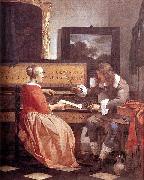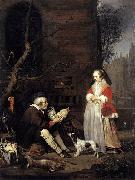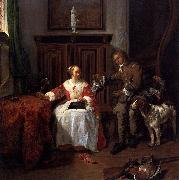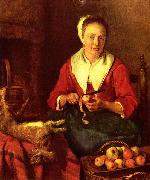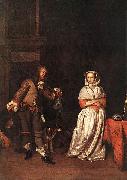Gabriel Metsu El petróleo que Pinta la ReproducciónAll Gabriel Metsu Oil PaintingsGabriël Metsu Gabriël Metsu (January 1629 - buried 24 October 1667) was a Dutch painter of history paintings, genre works and portraits. Metsu was the son of the Flemish painter Jacques Metsu (c.1588-1629), who lived most of his days at Leiden, and Jacomijntje Garniers, his third wife, whom he married in 1625. Jacomijntje was the widow of a painter with three children of her own. Two months after Gabriël's birth, his father died. According to Jacobus Houbraken, Metsu was taught by Gerard Dou, though his early works do not lend colour to this assertion. He was influenced by painters of Leiden such as Jan Steen, and later by Frans van Mieris the Elder. Metsu was registered among the first members of the painters' corporation at Leiden; and the books of the guild also tell us that he remained a member in 1649. In Leiden, it was alleged that Metsu left a brothel at six in the morning and took a prostitute to the Academy. In 1650 he ceased to subscribe, and works bearing his name and the date of 1653 support the belief that he had moved. Metsu was trained in Utrecht by Jan Baptist Weenix and Nicolaus Knepfer. In Amsterdam Metsu lived in an alley on Prinsengracht, where he kept chickens. He got into an argument with a neighbor and moved to a house on the canal side, where a daily vegetable market was held. In 1658 he married Isabella de Wolff, whose father was a potter and mother a painter. The Speed Art Museum has a portrait of the couple. Pieter de Grebber, a religious painter from Haarlem, was her uncle. At the onset of the 1660s Metsu turned for inspiration to the art of the "fijnschilders" from his native Leiden. Metsu was responding to the market of Dou's paintings, who sold his paintings all over for exorbitant prices. Metsu may have also influenced Pieter de Hoogh. Around the year 1661, Metsu won the patronage of the Amsterdam cloth merchant Jan J. Hinlopen and painted his family more than once in a fashionable surrounding. The Poultry-Seller, 1662 At least thirteen of paintings show carpets and he probably used the same model. He included several fine examples of minutely depicted floral and cloudband carpets in his works and even a silk Oriental rug, as well as so-called "Lotto" rugs which he for some reason, in contrast to his meticulous rendering of the floral carpets, depicted only in a very sketchy fashion. After Metsu died, his widow left for Enkhuizen, to live with her mother. |
|||

|
|||
|
|
|||
|
||||||||
| Gabriel Metsu Gabriël Metsu Gabriël Metsu (January 1629 - buried 24 October 1667) was a Dutch painter of history paintings, genre works and portraits. Metsu was the son of the Flemish painter Jacques Metsu (c.1588-1629), who lived most of his days at Leiden, and Jacomijntje Garniers, his third wife, whom he married in 1625. Jacomijntje was the widow of a painter with three children of her own. Two months after Gabriël's birth, his father died. According to Jacobus Houbraken, Metsu was taught by Gerard Dou, though his early works do not lend colour to this assertion. He was influenced by painters of Leiden such as Jan Steen, and later by Frans van Mieris the Elder. Metsu was registered among the first members of the painters' corporation at Leiden; and the books of the guild also tell us that he remained a member in 1649. In Leiden, it was alleged that Metsu left a brothel at six in the morning and took a prostitute to the Academy. In 1650 he ceased to subscribe, and works bearing his name and the date of 1653 support the belief that he had moved. Metsu was trained in Utrecht by Jan Baptist Weenix and Nicolaus Knepfer. In Amsterdam Metsu lived in an alley on Prinsengracht, where he kept chickens. He got into an argument with a neighbor and moved to a house on the canal side, where a daily vegetable market was held. In 1658 he married Isabella de Wolff, whose father was a potter and mother a painter. The Speed Art Museum has a portrait of the couple. Pieter de Grebber, a religious painter from Haarlem, was her uncle. At the onset of the 1660s Metsu turned for inspiration to the art of the "fijnschilders" from his native Leiden. Metsu was responding to the market of Dou's paintings, who sold his paintings all over for exorbitant prices. Metsu may have also influenced Pieter de Hoogh. Around the year 1661, Metsu won the patronage of the Amsterdam cloth merchant Jan J. Hinlopen and painted his family more than once in a fashionable surrounding. The Poultry-Seller, 1662 At least thirteen of paintings show carpets and he probably used the same model. He included several fine examples of minutely depicted floral and cloudband carpets in his works and even a silk Oriental rug, as well as so-called "Lotto" rugs which he for some reason, in contrast to his meticulous rendering of the floral carpets, depicted only in a very sketchy fashion. After Metsu died, his widow left for Enkhuizen, to live with her mother. |
||||||||
|
|
||||||||
| Pintura identificación:: 86949 Man and Woman Sitting at the Virginal between 1658(1658) and 1660(1660) Medium Oil on oak cyf |
||||||||
|
|
||||||||
| Pintura identificación:: 87011 The Poultry Seller 1662(1662) Medium Oil on oak panel cyf |
||||||||
|
|
||||||||
| Pintura identificación:: 87140 The Hunter s Gift Date between 1658(1658) and 1660(1660) Medium Oil on canvas Dimensions Height: 51 cm (20.1 in). Width: 48 cm (18.9 in). cjr |
||||||||
|
|
||||||||
| Pintura identificación:: 87212 Apfelschalerin Date c. 1660-1770 Medium Oil on canvas Dimensions 28 x 26 cm cjr |
||||||||
|
|
||||||||
| Pintura identificación:: 87241 The Hunter and a Woman second half of 17th century Medium Oil on wood cyf |
||||||||
|
|
||||||||
| ARTISTA PREVIO PROXIMO ARTISTA | ||||||||
|
|
||||||||
|
Gabriel Metsu Gabriël Metsu Gabriël Metsu (January 1629 - buried 24 October 1667) was a Dutch painter of history paintings, genre works and portraits. Metsu was the son of the Flemish painter Jacques Metsu (c.1588-1629), who lived most of his days at Leiden, and Jacomijntje Garniers, his third wife, whom he married in 1625. Jacomijntje was the widow of a painter with three children of her own. Two months after Gabriël's birth, his father died. According to Jacobus Houbraken, Metsu was taught by Gerard Dou, though his early works do not lend colour to this assertion. He was influenced by painters of Leiden such as Jan Steen, and later by Frans van Mieris the Elder. Metsu was registered among the first members of the painters' corporation at Leiden; and the books of the guild also tell us that he remained a member in 1649. In Leiden, it was alleged that Metsu left a brothel at six in the morning and took a prostitute to the Academy. In 1650 he ceased to subscribe, and works bearing his name and the date of 1653 support the belief that he had moved. Metsu was trained in Utrecht by Jan Baptist Weenix and Nicolaus Knepfer. In Amsterdam Metsu lived in an alley on Prinsengracht, where he kept chickens. He got into an argument with a neighbor and moved to a house on the canal side, where a daily vegetable market was held. In 1658 he married Isabella de Wolff, whose father was a potter and mother a painter. The Speed Art Museum has a portrait of the couple. Pieter de Grebber, a religious painter from Haarlem, was her uncle. At the onset of the 1660s Metsu turned for inspiration to the art of the "fijnschilders" from his native Leiden. Metsu was responding to the market of Dou's paintings, who sold his paintings all over for exorbitant prices. Metsu may have also influenced Pieter de Hoogh. Around the year 1661, Metsu won the patronage of the Amsterdam cloth merchant Jan J. Hinlopen and painted his family more than once in a fashionable surrounding. The Poultry-Seller, 1662 At least thirteen of paintings show carpets and he probably used the same model. He included several fine examples of minutely depicted floral and cloudband carpets in his works and even a silk Oriental rug, as well as so-called "Lotto" rugs which he for some reason, in contrast to his meticulous rendering of the floral carpets, depicted only in a very sketchy fashion. After Metsu died, his widow left for Enkhuizen, to live with her mother. |
||||||||
|
|
||||||||
|
CONTACTE EEUU |





